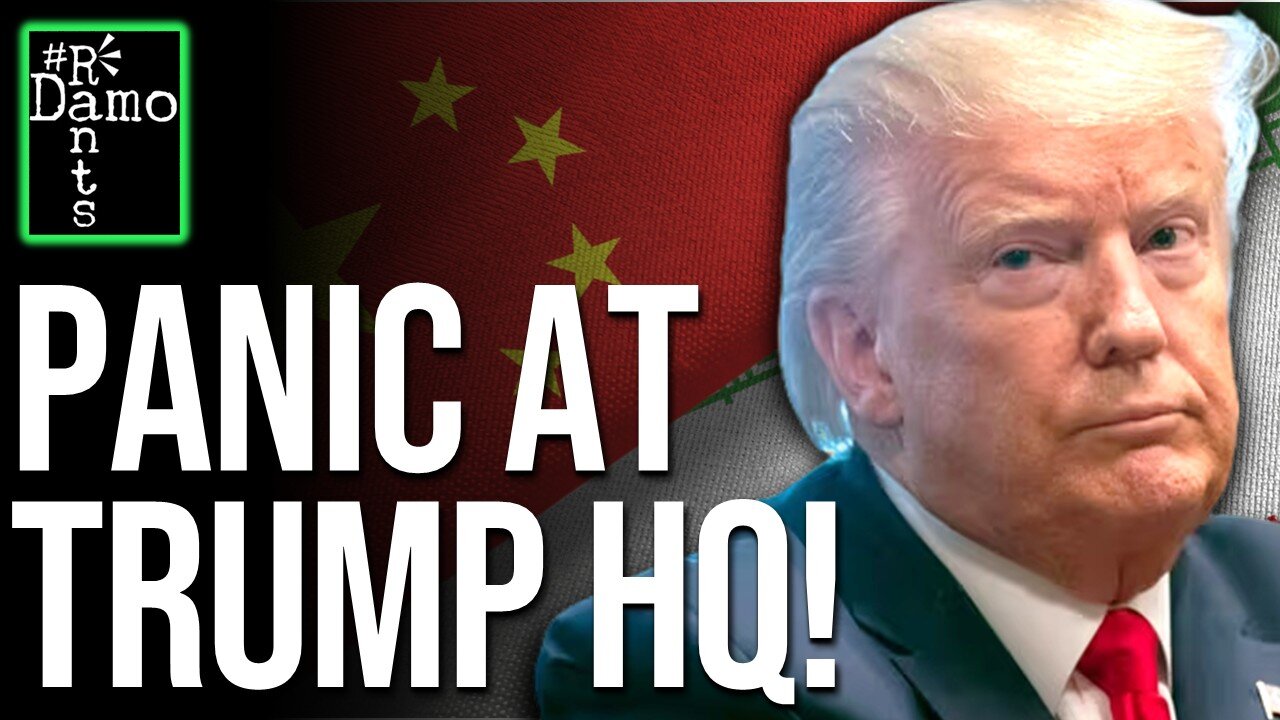Premium Only Content

Trump Sanctioned the World — And Ended Up Sanctioning Himself
Right, so it takes a peculiar kind of genius to keep sanctioning the same countries for the same behaviour and expect a different result — but Donald Trump has always believed thuggery and bullying can substitute for strategy if he just punches harder. His latest performance, targeting China and Iran for daring to trade without the US dollar and therefore getting around US sanctions is less foreign policy than public therapy: a loud reminder to himself that Washington still matters and that he’s the biggest boy in the room. Fifty new sanctions later, Beijing hasn’t blinked, Tehran’s oil is still moving in China’s direction, and the only market that reacted was Wall Street as the stock market throws a wobbler. The man who promised to make America great again has instead made it paranoid, sanctioning half the planet just to prove he’s in charge. The dollar is losing friends, the world is losing patience, and the only thing Trump is actually punching is himself in the face — convinced if he just hits harder it means he’s winning.
Right, so the United States Treasury has just announced another sanctions package targeting the Iranian energy network. Roughly fifty individuals, companies, and vessels have been blacklisted for allegedly helping Tehran sell oil in defiance of existing restrictions. Several of these entities were Chinese, including refiners operating through Shandong and Zhoushan. The Zhoushan Lianyong Petrochemical plant had processed blended crude from what Washington calls Iran’s “shadow fleet” — ships re-flagged or renamed to conceal origin, something I spoke about in another video the other day.
Donald Trump’s team has presented the move as proof of American resolve. Treasury officials described it as unwavering enforcement of sanctions. Yet the optics tell a different story because the bloviating blood vessel fit to burst that passes for the US President has ballsed up again. Stock markets fell immediately: the S&P 500 dropped 2.7 percent, the Nasdaq 3.5 percent. Investors were not watching power being exercised; they were watching anxiety take the stage.
Trump claims that no one evades U.S. sanctions. But behind that claim, shares were tumbling and tankers kept on sailing. The gap between his triumphalism and market reaction quickly became a gaping chasm - a leader declaring victory as his own economy flinched. Nero fiddling as Rome burns if you like.
It was the gesture of control that revealed a loss of control. The one instrument Washington always reaches for — the dollar-based sanction — no longer frightens those it targets. It only unsettles those who impose it.
American sanctions once worked because the dollar ruled the global financial system. Any transaction crossing New York’s clearing houses could be blocked with a single designation. That authority has not disappeared, but it is no longer absolute. The IMF’s 2024 reserve-currency data show the dollar’s share falling below 58 percent, its lowest since records began. Research published this year records over 1,200 banks in 110 countries linked to China’s Cross-Border Interbank Payment System now, allowing settlements in yuan entirely outside the dollar based SWIFT system.
These are not theoretical escape routes; they are operating circuits. Every overused sanction teaches another government how to use a viable alternative. The more Washington weaponises access via its sanctions, the more the world builds immunity by taking another route. The result is structural erosion of the leverage that sanctions once conferred and the influence of the dollar and therefore the US weakens each and every time.
The pattern is visible in numbers, not rhetoric. IMF, central-bank, and commercial-clearing data show steady diversification away from dollar settlements. Washington’s “maximum pressure” approach has become a self-paced tutorial in how to live without the dollar.
Beijing’s answer to Trump’s latest measures came within forty-eight hours and was clinical. Yesterday, its Ministry of Transport imposed retaliatory port fees on US-linked vessels. AP News and the Wall Street Journal confirmed the specifics: from 14 October, any ship that is US-built, US-owned, US-flagged, or majority US equity would pay 400 yuan per net ton for each voyage to Chinese ports, capped at five voyages per year. A Chinese Foreign Ministry spokesperson described it as “a necessary response to illegal and discriminatory actions,” a phrase repeated in much foreign media coverage. Other reports cited maritime analysts who estimated that the fees could raise US carrier costs on East Asian routes by 10–15 percent.
Simultaneously, Beijing introduced new export-licensing rules on rare earth elements. Because China supplies about 70 percent of global output, these rules give it a lever over US electronics and weapons manufacturing. This kicks Silicon Valley straight in the transistors. Each step was procedural, not performative — administrative patience confronting political theatre.
Here was the first reversal. The United States intended to tighten the screws; instead, it provoked a quiet squeeze on its own logistics and supply chains.
The deepest challenge to Washington’s sanctions regime lies in the quiet revival of barter. This is what I covered the other day, so I won’t go back over that too much here, but Chinese firms are purchasing Iranian oil through infrastructure exchanges rather than cash: power plants, railways, and automotive projects paid for with crude oil, not dollars. Another report in the same vein has confirmed that the Chinese car manufacturer Chery had swapped semi-assembled vehicles for Iranian copper. Another barter system proving extremely workable. These deals are fully documented, not speculative.
In practice, this means sanctions no longer block trade — they simply redirect it. Export data shows Iran shipping an average of 1.7 million barrels of crude per day by the middle of this year, its highest level since before the US left the JCPOA agreement with Iran in 2018. If the objective was isolation therefore, the result is integration by other means. The sanctions built the very parallel network they were meant to prevent.
Iran’s adaptation is seen in its shipping methods. The “shadow fleet,” roughly 300 tankers according to open maritime registries, moves oil via re-flagging and mid-ocean transfers. Each re-flagged ship is an act of learned resistance. After two decades of restrictions, Iran now treats sanctions as a predictable cost of it doing business, not an obstacle. So they adapted. That is the definition of policy failure.
Trump’s model relies on escalation: if one list fails, publish another. But deterrence depends on scarcity. Once punishment becomes routine, it ceases to deter. Sanctions fatigue has crept in across industries and governments. That is visible in supply-chain behaviour now. Businesses now view Washington as a risk variable, not a guarantor of stability.
Every sanction intended to demonstrate control instead signals unpredictability. Markets respond accordingly.
Within the United States, sanctions serve electoral optics more than strategy. They deliver headlines about toughness but also feed inflation. Importers face higher costs for Chinese electronics and pharmaceuticals; exporters meet retaliatory tariffs. Logistics firms have warned that freight rates from Chinese ports to Los Angeles will rise by 10–12 percent after Beijing’s port-fee measure. Those increases feed directly into consumer prices and corporate anxiety.
While Trump proclaims victory from the podium, the American public pays the bill at the checkout. The disjunction between image and impact is factual, not rhetorical: the same week he announced new penalties on China, US markets lost hundreds of billions in value. The punishment lands inwards.
Beyond the West, the reaction was indifference mixed with recognition. Tehran quoted economists arguing that US unilateralism “reveals fear of equality.” Other reports called it the moment Washington’s power became “performative rather than persuasive.” Across Africa, Asia, and Latin America, governments note that defiance can now succeed. Membership in BRICS and the Shanghai Co-operation Organisation continues to grow. Therefore each American attempt to isolate rivals accelerates the creation of alternative alliances.
What was once a sanctions regime is becoming a catalyst for multipolar coordination and increasingly US isolation.
For Trump, sanctions are stagecraft. They require no congressional approval, cost no US casualties, and feed the image of decisive leadership and toughness. But the absence of measurable goals betrays their emptiness. Treasury press briefings outline no benchmarks for success, only vows of persistence. Therefore sanctions now exist only to prove action, not to achieve any definable outcomes.
The government punishes to display movement — a cycle of gestures replacing policy.
European officials no longer disguise their frustration at it either. EU sources have apparently called Trump’s new measures “counter-productive.” Each new unilateral US decision nudges allies toward systems that Washington cannot police.
Empires historically mistake enforcement for strength. Britain’s maritime coercion once ensured compliance until others built fleets of their own. The US now enforces through software and settlement law, but the dynamic is unchanged. Trump’s sanctions reflect that same inflection point. They are not instruments of order but symptoms of fatigue. This is an analytical inference grounded in comparative historical research, not speculation: dominant powers always decline when punishment replaces partnership.
While Washington escalates, Beijing consolidates. Projects under the 25-year Iran–China Co-operation Agreement continue to expand. Reports have confirmed new rail and port developments linking Iran to Central Asia. Each addition strengthens a trade network that cannot be switched off by US decree.
Iranian officials now treat every new sanction as validation. Oil Minister Javad Owji told state television on 10 October that exports to “friendly nations” were continuing at record levels, a claim aligned with those reports of 1.7 million barrels per day. Tehran’s reading is blunt: if the world keeps buying and the United States keeps sanctioning, then the policy has failed. Each renewed measure strengthens Iran’s claim to sovereignty within the Global South. It is a narrative built entirely on documented trade flows.
The balance sheet is straightforward. Fifty entities sanctioned. Iranian exports up. Chinese oil purchases steady. US shipping costs higher by roughly 10 percent. Rare-earth controls unsettle technology markets. Dollar share of reserves declining. CIPS participation rising. Each figure is confirmed in public reporting. Together they chart an inversion: every attempt at enforcement reduces the enforcer’s advantage. That is not a political opinion; it is a series of audited and reported outcomes.
Trump’s rhetoric describes these actions as “warning shots.” The real warning is directed at Washington itself. When a government spends its energy tracking bartering partners and individual captains, it reveals managerial panic, not authority. Beijing and Tehran keep trading; global markets adjust; only the sanctioner feels the strain.
The US Treasury’s own database lists more than 9,000 entities under sanction. Congressional Research Service analysis from 2024 estimates that these designations affect about one-tenth of the world’s active commercial workforce through direct or secondary exposure. When coercion becomes that broad, it ceases to be selective and starts to be structural — an admission that Washington has no other tool left.
Each new list is less about the target and more about maintaining the appearance of momentum and control.
But the fact of the matter is that China and Iran have built a functional alternative to US financial oversight.
Enforcement no longer signals confidence; it signals insecurity. A nation certain of its position does not need to blacklist the world to prove it still leads it. The inference — grounded in observable behaviour — is that the US is acting out its supremacy rather than exercising it.
The entire edifice of sanctions depends on belief — the belief that US rules are universal. In 2025, that belief is visibly weakening. Each new designation is a press release announcing diminished reach. The United States is punishing China and Iran not for breaking its system but for proving they can function outside it. The consequence is a slow, measurable isolation of the sanctioner itself. The world is learning to trade around America.
Chinese imports of Iranian oil stand at near-record levels. Iran’s energy revenues remain stable. Global markets fluctuate more in response to US announcements than to Chinese or Iranian behaviour. The dollar’s share of global reserves continues to fall, and participation in alternative payment systems continues to rise. All of these outcomes are verified in published data.
Trump’s October sanctions were meant to demonstrate dominance. Instead, they have exposed fragility. The self-image of control has become its own contradiction. Sanctions no longer restrain adversaries; they teach them how to live without the enforcer. The world now sees Washington policing a system that fewer and fewer need to obey.
The blunt truth is captured in one sentence: Trump mistook punishment for power. Every measure he signs hits home before it lands abroad. The United States is sanctioning itself in effect.
So if sanctions no longer work, what does Washington have left?
For more on how China and Iran have broken the US sanctions system and how returning to bartering has done it, check out this video recommendation here as your suggested next watch.
Please do also hit like, share and subscribe if you haven’t done so already so as to ensure you don’t miss out on all new daily content as well as spreading the word and helping to support the channel at the same time which is very much appreciated, holding power to account for ordinary working class people and I will hopefully catch you on the next vid. Cheers folks.
-
 8:45
8:45
Millionaire Mentor
19 hours agoDevin Nunes SHOCKED Everyone After EXPOSING The Deep State’s Dirty Secret
10.8K5 -
 2:01:40
2:01:40
BEK TV
1 day agoTrent Loos in the Morning - 10/15/2025
9.6K1 -
 2:53
2:53
OfficialJadenWilliams
17 hours agoWhen GTA 6 is TOO detailed...
11K1 -
 LIVE
LIVE
FyrBorne
12 hours ago🔴Battlefield 6 Live M&K Gameplay: Finding The Real GOATs of Battlefield 6
98 watching -
 50:14
50:14
Coin Stories with Natalie Brunell
1 day agoUptober, Q4, and Bitcoin’s Next Leg with Mark Moss
79.9K14 -
 LIVE
LIVE
Lofi Girl
2 years agoSynthwave Radio 🌌 - beats to chill/game to
134 watching -
 2:03:38
2:03:38
Midnight In The Mountains™
3 hours agoMorning Coffee w/ Midnight & The Early Birds | Musks Starlink Falling from Heaven... Internet Heaven
10.6K1 -
 42:12
42:12
PudgeTV
3 hours ago🔴 The Forever Winter | The 3 Rumskateers Adventure into Darkness
6.84K1 -
 31:05
31:05
Liberty Hangout
1 day agoAnti-Fascists Can't Define Fascism
139K165 -
 2:35:27
2:35:27
FreshandFit
10 hours agoThe Biggest Debt Problem in America
113K15